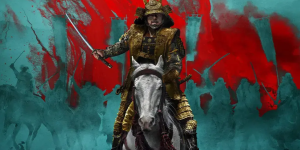
FX's "Shogun," an adaptation of Clavell's 20th c. novels, debuted this year to great fanfare from viewers everywhere. Shogun takes place at the end of Japan's massive civil war, the Sengoku period, and features a character stand in for Tokugawa Ieyasu, the man who completed the unification of Japan. Shogun maintains a deep and careful attention to the material history of Japan (period accurate costumes, weaponry, and architecture), the culture of Japan (classical japanese spoken language, noble traditions of poetry recitation, accurate portrayal of Noh), and its history (the important influence of foreign technologies in Japanese civil conflicts, the rise of military Bakufu government under a shogun). Besides being wildly entertaining, Shogun would be a great medium to engage students in the sights, sounds, and cultural norms of a Japan at war.



Very true! FX's "Shogun" offers a rich tapestry for exploring various historical, cultural, and thematic topics in the classroom.
Here are five themes and corresponding activities that can be used to engage students with the series:
1. Theme: Feudal Japan and Political SystemsActivity: Create a Feudal Japan Map and Hierarchy Diagram
Description: Have students research the structure of feudal Japan and create a detailed map showing the division of lands among different daimyos, as well as a hierarchy diagram illustrating the relationships between the shogun, daimyos, samurai, and peasants.
Objective: To understand the political and social organization of feudal Japan and how it influenced the Sengoku period.
Activity: Role-Play a Feudal Japanese Court
2. Theme: Cultural Traditions and Art FormsDescription: Students can take on different roles (shogun, daimyo, samurai, etc.) and reenact a historical court scene or negotiation. They can prepare speeches or arguments based on their roles and historical context.
Objective: To explore the political dynamics and power struggles of the era.
Activity: Noh Theater Performance
Description: Students can learn about Noh theater, including its history, themes, and performance style. They can then prepare and perform a short Noh play or a scene from one.
Objective: To appreciate traditional Japanese performing arts and understand their role in historical and cultural contexts.
Activity: Japanese Poetry Workshop
3. Theme: The Impact of Foreign InfluenceDescription: Introduce students to classical Japanese poetry forms such as Haiku or Tanka. Students can write their own poems and present them in a class poetry reading.
Objective: To explore Japanese literary traditions and express personal interpretations of historical and cultural themes.
Activity: Debate on Foreign Influence in Japan
Description: Organize a debate on the effects of foreign technologies and ideas on Japanese society during the Sengoku period. Topics could include the introduction of firearms, Christianity, or Western technology.
Objective: To analyze the role of foreign influences in shaping Japanese history and culture.
Activity: Research Project on European Explorers in Japan
4. Theme: The Role of Warfare and StrategyDescription: Have students research European explorers and missionaries who visited Japan during the Sengoku period. They can create presentations or reports on their findings.
Objective: To understand the historical interactions between Japan and European countries.
Activity: Simulate a Sengoku Battle Strategy
Description: Students can work in groups to develop strategies for a historical Sengoku battle. They will research historical battles and present their strategies, including troop movements, tactics, and objectives.
Objective: To explore military tactics and strategic thinking during the Sengoku period.
Activity: Create a Historical Battle Diorama
5. Theme: Historical Accuracy vs. Artistic InterpretationDescription: Students can create dioramas depicting famous battles from the Sengoku period, focusing on accurate representations of military tactics, weaponry, and terrain.
Objective: To visualize and understand the scale and complexity of historical battles.
Activity: Compare "Shogun" to Historical Sources
Description: Have students compare scenes from "Shogun" to historical records, primary sources, or academic texts about the Sengoku period. They can analyze the differences between historical fact and artistic interpretation.
Objective: To critically evaluate the accuracy of historical depictions in media and understand the role of creative liberties in storytelling.
Activity: Create a Historical Fiction vs. Non-Fiction Presentation
Description: Students can create a presentation comparing how historical events are portrayed in fiction (like "Shogun") versus non-fiction sources (like history books or documentaries).
Objective: To develop skills in distinguishing between historical fact and fiction and exploring the reasons for artistic choices in historical narratives.